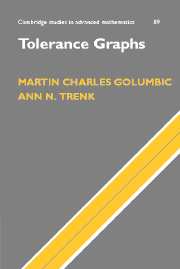Book contents
- Frontmatter
- Contents
- Chapter Dependencies
- Preface
- 1 Introduction
- 2 Early work on tolerance graphs
- 3 Trees, cotrees and bipartite graphs
- 4 Interval probe graphs and sandwich problems
- 5 Bitolerance and the ordered sets perspective
- 6 Unit and 50% tolerance orders
- 7 Comparability invariance results
- 8 Recognition of bounded bitolerance orders and trapezoid graphs
- 9 Algorithms on tolerance graphs
- 10 The hierarchy of classes of bounded bitolerance orders
- 11 Tolerance models of paths and subtrees of a tree
- 12 φ-tolerance graphs
- 13 Directed tolerance graphs
- 14 Open questions and further directions of research
- References
- Index of Symbols
- Index
9 - Algorithms on tolerance graphs
Published online by Cambridge University Press: 11 August 2009
- Frontmatter
- Contents
- Chapter Dependencies
- Preface
- 1 Introduction
- 2 Early work on tolerance graphs
- 3 Trees, cotrees and bipartite graphs
- 4 Interval probe graphs and sandwich problems
- 5 Bitolerance and the ordered sets perspective
- 6 Unit and 50% tolerance orders
- 7 Comparability invariance results
- 8 Recognition of bounded bitolerance orders and trapezoid graphs
- 9 Algorithms on tolerance graphs
- 10 The hierarchy of classes of bounded bitolerance orders
- 11 Tolerance models of paths and subtrees of a tree
- 12 φ-tolerance graphs
- 13 Directed tolerance graphs
- 14 Open questions and further directions of research
- References
- Index of Symbols
- Index
Summary
Interval relations play a significant role in many resource allocation, temporal reasoning, biological and scheduling problems. We saw this in Sections 1.1 and 4.1 in our motivating examples for interval graphs, tolerance graphs and interval probe graphs. Intervals can represent events in time, which may conflict or may be compatible. They can represent certain tasks to be performed according to a timetable which must be assigned distinct processors or people. Or they may represent fragments of DNA, which are compatible or incompatible.
For many optimization problems, such as graph coloring or finding maximum stable sets, there are efficient algorithms that give solutions when the set of graphs under consideration is restricted to a structured family. Many applications reduce to solving optimization problems on such families of graphs. Indeed, at the very beginning of this book, a 4-coloring of the tolerance graph in Figure 1.3 provided an assignment of four meeting rooms for that motivating example. In a similar application, with say only one room available for a given collection of meetings (intervals) with tolerances, a maximum stable set would provide the largest number of meetings from the collection that can be scheduled. In this chapter, we investigate these algorithmic aspects of tolerance graphs.
Narasimhan and Manber (1992) were the first to study the chromatic number, clique and stable set problems for representations of tolerance graphs.
- Type
- Chapter
- Information
- Tolerance Graphs , pp. 135 - 145Publisher: Cambridge University PressPrint publication year: 2004



